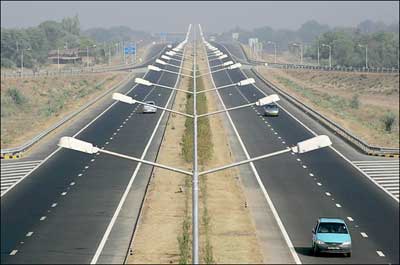|
In today's India, status comes with four wheels
(nytimes.com)
Updated: 2005-12-05 12:02 VISHAKHAPATNAM, India - On the
dark highway, the car showroom glowed in the night like an American drive-in.
Inside, it looked more like a game-show set: bright lights, white floors, huge
windows, high ceilings and ad posters of beaming consumers far paler than most
Indians. For 36-year-old Ram Reddy, the price was right enough to make a down
payment on his fifth family car.
He and his brother already had one car "for the children," two "for the
ladies," and so on. Now they were buying the Toyota Innova, a big-as-a-boat
luxury van that retails for a minimum of $23,000, 46 times India's per capita
income of about $500.

The new national
highway in Rajasthan State, India. The revamped highways are feeding a new
appetitie for fast cars. [nytimes.com] | The
Innova is a new plaything of the moneyed here, one being peddled, like so many
products in India today, by a Bollywood star. It is yet another symbol of the
kid-in-a-candy-store psyche that has seized India's growing consuming class,
once denied capitalism's choices and now flooded with them.
Fifteen years after India began its transition from a state-run to a
free-market economy, a new culture of money - making it, and even more, spending
it - is afoot.
This domestic hunger for goods has become an important engine for an economy
that still lags in exports. So intense is the advertising onslaught, so giddy
the media coverage of the new affluence, that it is almost easy to forget that
India remains home to the world's largest number of poor people, according to
the World Bank.
Still, India's middle class has grown to an estimated 250 million in the past
decade, and the number of super-rich has grown sharply as well.
And, after more decades of socialist deprivation, when consumer goods were so
limited that refrigerators were given pride of place in living rooms, they have
ever more wares to spend it on: cellphones, air-conditioners and washing
machines; Botox, sushi and Louis Vuitton bags; and, perhaps the biggest status
symbol of all, cars.
India has become one of the world's fastest-growing car markets, with about a
million being sold each year. It once had only two kinds, Fiats and Ambassadors.
Now dozens of models ride the roads, from the humble, Indian-made Maruti to the
Rolls-Royce, which has re-entered India's market some 50 years after leaving in
the British wake.
Indians are discovering in cars everything Americans did: control and
freedom, privacy and privilege, speed and status. Car showrooms, the bigger the
better, are the new temples here, and cars the icons of a new individualism
taking root. Foreign car companies, meanwhile, have discovered the Indian
consumer - not to mention the country's engineering brain power - and are
setting up plants across India.
The growing lust for cars also reflects India finally having roads decent
enough to drive them on. It is making a historic effort to upgrade its dismal,
mostly two-lane national highway system into four- or six-lane interstates, its
largest infrastructure project since independence in 1947.
A New York Times reporter and a photographer drove one portion of the
project, the so-called Golden Quadrilateral, which passes through New Delhi,
Calcutta, Madras, officially known as Chennai, and Mumbai, formerly Bombay,
earlier this year.
The revamped highways mean that, for the first time in India, cars can go
fast; thus the new appetite for fast cars. The middle and upper classes, already
being lured by one of the world's fastest-growing domestic airline industries,
are discovering driving for pleasure as much as need.
"This is the American 1950's happening in India now," said Padma
Chandrasekaran, a Madras resident marveling at the new ease of driving the 205
miles to Bangalore.
The new highways have seduced well-off consumers like Mr. Reddy, who plans to
use the Innova for family road trips to places like the temple at Tirupati,
about 400 miles south of here, a trip he would previously have made by train.
The highway's smoother surfaces and additional lanes have also enriched him, by
reducing fuel and maintenance costs for his trucking company.
"If the roads were not good, we would not have this many cars," said the
bearded Mr. Reddy, whose 9-year-old son already knows how to steer an
automobile.
|